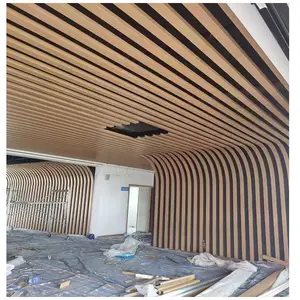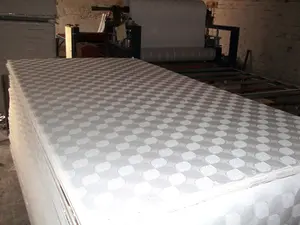(33636 products available)














































































































































































































































Perforated ceiling panels are widely used in commercial spaces because of their ability to control sound and for decorative purposes. They come in different materials, such as:
Metal perforated ceiling panels
Metal perforated ceiling panels are made from different types of metals, such as aluminum and steel. Most of them are made of aluminum because it is lightweight and durable. Metal ceiling panels are popular because they are easy to maintain and can be customized. They come in different sizes and the holes in the panels can be made in different patterns. The perforated holes in the ceiling panels are sometimes covered with a black acoustic fabric that improves the appearance and reduces sound leakage. These metal panels are commonly used in offices and airports.
Gypsum perforated ceiling panels
Gypsum perforated ceiling panels are popular in commercial and residential buildings. They are preferred because they are very cost-effective. These ceiling panels have small holes that are arranged in a pattern. The holes improve the acoustic properties of the ceiling panels. Some gypsum ceiling panels have a smooth and solid surface that is located behind the panel to improve sound absorption. They are also very versatile and can be painted to match the interior design of a room.
Wood perforated ceiling panels
Wood perforated ceiling panels are used when a warm and natural feeling is required in a room. They are made with different types of wood, such as engineered wood, MDF (Medium Density Fiberboard), and natural wood. The acoustic properties of these ceiling panels are improved by treating the back of the panel with acoustic material. They are preferred because they are environmentally friendly. The wood ceiling panels are used in meeting rooms and high-end restaurants.
Plastic perforated ceiling panels
These ceiling panels are made from different types of plastics, such as PVC (Polyvinyl Chloride). They are very lightweight and come in different colors and designs. They are used in areas where there is moisture, like swimming pools and bathrooms. This is because they are resistant to moisture and very easy to maintain.
Perforated ceiling panels are used widely for commercial and residential purposes. They provide a lot of benefits. The main functions of perforated ceiling panels include:
Perforated ceiling panels have many important functions and features that are very useful for keeping buildings in good shape and making them comfortable places to be.
Perforated ceiling panels have various applications and usage scenarios across different industries and environments. Here are some common usage scenarios:
Commercial Buildings
Office Spaces: Perforated panels can be used in office ceilings to improve acoustics and reduce noise levels. They can also be designed to incorporate lighting fixtures.
Conference Rooms: In conference rooms, perforated ceiling panels are used to create a quiet and professional environment for meetings and presentations. They help minimize echo and background noise.
Retail Stores: Perforated ceiling panels are used in retail stores to create an aesthetically pleasing environment while maintaining sound quality for customers and staff. They also allow for overhead lighting.
Educational Institutions
Classrooms: Perforated ceiling panels are used in classrooms to enhance speech intelligibility and reduce noise distractions. This creates a better learning environment for students and teachers.
Auditoriums: In auditoriums, perforated panels are used to control sound reflections and create an optimal acoustic environment for performances and presentations. The panels can be customized to match the design of the space.
Healthcare Facilities
Hospitals: Perforated ceiling panels are used in hospitals to reduce noise levels in patient rooms and ensure a calm and healing environment. They are also easy to clean and maintain.
Clinics: In clinics, perforated ceiling panels are used in examination rooms and waiting areas to improve acoustics and provide a comfortable environment for patients and staff.
Hospitality Industry
Hotels: Perforated ceiling panels are used in hotel lobbies, meeting rooms, and guest rooms to enhance aesthetics and acoustic comfort. They contribute to a pleasant guest experience.
Restaurants: In restaurants, perforated ceiling panels are used to control noise levels and create a pleasant dining atmosphere. They can also complement the overall interior design.
Public Spaces
Museums: Perforated ceiling panels are used in museums to protect artwork from direct lighting while maintaining adequate illumination. They also help control noise levels in exhibition spaces.
Libraries: In libraries, perforated ceiling panels are used to create a quiet and serene environment conducive to reading and studying. They help minimize sound propagation.
Industrial and Manufacturing
Factories: Perforated ceiling panels are used in industrial spaces to improve acoustics and reduce noise from machinery. This helps create a more comfortable working environment.
Workshops: In workshops, perforated panels can be used to improve sound quality and reduce noise pollution, especially in areas where precision work is conducted.
Residential Applications
Living Areas: Perforated ceiling panels can be used in living rooms, bedrooms, and dining areas to enhance aesthetics and acoustics. They provide a stylish and functional ceiling solution.
Kitchens and Bathrooms: In kitchens and bathrooms, perforated ceiling panels are used to improve ventilation and reduce moisture buildup. They can be easily cleaned and maintained.
There are many factors to consider when choosing the right perforated ceiling panels for a specific application. Here are some of them:
Functionality
The primary purpose of a perforated ceiling panel should be the first thing business owners consider. Determine whether sound absorption, air circulation, or aesthetic appeal is the main goal. Different panels excel in various functions, so select one that matches the intended purpose.
Material
Consider the perforated ceiling panel's material. Common options include metal, wood, and acoustic tiles. Metal is durable and easy to maintain, while wood offers a warm, natural feel. Acoustic tiles are specifically designed for sound absorption. Each material has unique benefits and drawbacks, so choose one that fits the space and budget.
Perforation pattern
The perforation pattern on the ceiling panels affects both aesthetics and performance. Sleek, uniform patterns create a modern look, while traditional designs add character to a space. Denser perforations provide better sound absorption, whereas larger gaps improve ventilation. Consider the desired visual effect and functional requirements when selecting a pattern.
Durability and maintenance
Durability is essential for any ceiling investment. Assess the expected foot traffic and environmental conditions to determine the necessary panel strength. Choose low-maintenance materials that withstand cleaning and repairs if the ceiling is installed in a high-traffic or commercial area.
Aesthetics
The ceiling panels significantly impact the room's overall appearance, so choose one that complements the design style. Consider the color, texture, and shape of the perforated panels. Sleek, white acoustic tiles suit contemporary spaces, while decorative wood panels add warmth and charm to any room.
Installation
Consider the installation process when choosing perforated ceiling panels. Some options, like suspended ceilings, are easier to install and permit future modifications. Others, like drywall ceilings, require more work but provide a seamless finish. Assess the skill level and resources available to determine the best installation method.
Budget
Perforated ceiling panels are available at various price points, so consider the budget when making a choice. While cheaper options may be tempting, investing in quality panels that last and meet performance needs is essential. Balance the cost with expected longevity and functionality to make a financially sound decision.
Q: Why choose a perforated ceiling over other types?
A: Perforated ceilings offer unique benefits. First, they control sound. The small holes in the panels help reduce echoes and make rooms quieter. Second, they allow light. A perforated design lets light bulbs shine brighter without glare. Third, they're cool-looking. Designers love how the patterns give ceilings a modern style. Lastly, installation is easy. Builders appreciate how simple perforated panels go up compared to solid panels.
Q: What are the drawbacks of a perforated ceiling?
A: The main downside is maintenance. Because the holes trap dirt, perforated ceilings need more cleaning than solid ones. Areas like kitchens and bathrooms require regular washes to prevent buildup. Home and business owners should be ready for this extra work to keep ceilings pristine.
Q: Are perforated ceiling panels waterproof?
A: Most perforated ceiling panels are not waterproof. Standard panels resist moisture but are not fully waterproof. Builders install them in dry areas. If a project calls for a waterproof ceiling, special panels are ordered. These have sealed perforations to block water. Waterproof ceilings are needed for bathrooms, kitchens, and other wet rooms.
Q: Do perforated ceiling panels affect lighting?
A: No, perforated panels do not dim lights. In fact, the small holes improve light diffusion. They spread light evenly across rooms. This reduces harsh shadows. The patterns also reduce glare from bright bulbs. Overall, perforated panels create a softer, more comfortable illumination.
Q: Are perforated ceiling panels easy to install?
A: Yes, perforated ceiling panels go up just like regular solid panels. Builders hang them using grid systems. The process is not complicated. As long as the right panels are chosen for each project, installation should pose no issues.